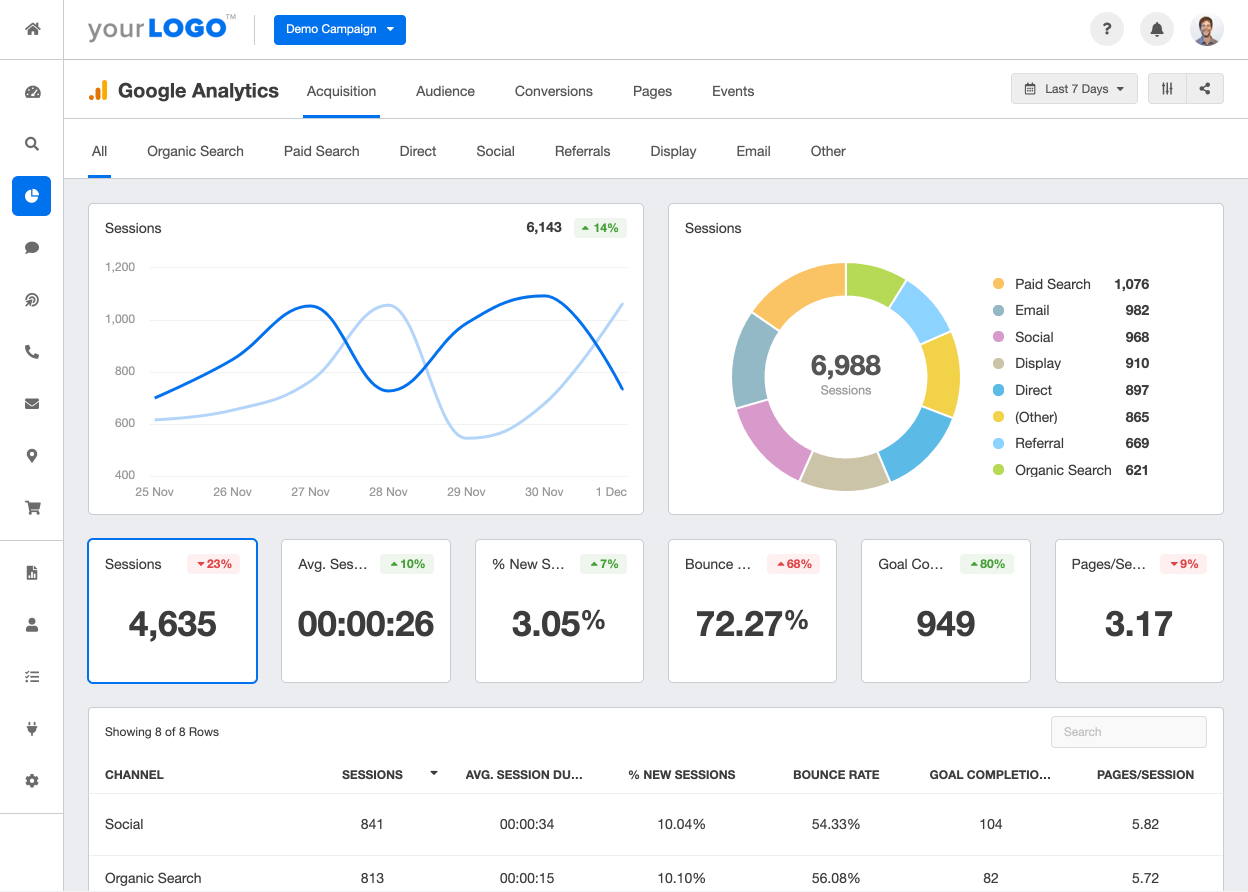Lead generation is a crucial aspect of any business strategy. By effectively capturing and nurturing potential customers, businesses can increase their sales and grow their customer base. However, to truly understand the effectiveness of lead generation efforts, businesses need to measure and analyze key metrics.
Defining Lead Generation
In simple terms, lead generation refers to the process of attracting potential customers and converting them into leads – individuals who have expressed interest in your product or service. Lead generation metrics are measurements that help businesses gauge the success of their lead generation efforts.
Why Metrics Matter in Lead Generation
Metric tracking is essential for businesses to assess the success or shortcomings of their lead generation efforts. By analyzing key metrics, businesses can identify what is working well and what areas need improvement. Metrics, as below, also provide valuable insights into customer behavior and preferences, allowing businesses to refine their strategies and optimize their lead generation processes. Here are some essential:
- Conversion Rate: Measures lead-to-customer success, indicating lead quality and nurturing effectiveness.
- Cost per Lead: Tracks lead acquisition cost, helping assess campaign ROI and identify cost-saving opportunities.
- Customer Behavior Insights: Click-through rates, bounce rates, and time spent on page reveal audience engagement and inform future marketing efforts.
- Data-Driven Decisions: Metrics guide optimization of lead generation processes across various channels.
- Essential for Success: Understanding and leveraging metrics is crucial for attracting and converting customers.

Types of Lead Generation Metrics
To fully understand the effectiveness of lead generation efforts, which will lead to more conversions and increased traffic, businesses should track various metrics that provide valuable insights. These metrics can be categorized into three main categories:
Volume-Based Metrics
Volume-based metrics focus on measuring the quantity of leads generated during a specific time period. These metrics provide businesses with a broad overview of the quantity of leads generated and can be a good starting point for assessing the overall success of lead generation campaigns.
One important volume-based metric is the number of leads captured. This metric indicates the total number of individuals who have expressed interest in the business's products or services. By tracking this metric, businesses can gauge the level of demand and the effectiveness of their lead generation efforts.
Another volume-based metric is the overall increase in the subscriber base. It is the growth in the number of subscribers to an email list or newsletter. With it, businesses can measure the success of their lead generation efforts in building a loyal audience and nurturing potential customers.
Time-Based Metrics
Time-based metrics focus on measuring the effectiveness of lead generation efforts over a specific period of time. These metrics help businesses identify bottlenecks in their lead generation process and optimize their strategies for quicker and more efficient conversions.
One time-based metric is the average time it takes to convert a lead into a customer. This metric provides insights into the efficiency of the sales process and helps businesses identify areas where improvements can be made to shorten the conversion time and increase the overall conversion rate.
Cost-Based Metrics
Cost-based metrics determine the cost-effectiveness of lead generation efforts. These metrics help businesses assess the return on investment (ROI) of their lead generation activities and make informed decisions about where to allocate resources for maximum impact.
Businesses can track the costs associated with various lead generation channels, such as advertising costs, content creation costs, or software expenses. By comparing these costs to the number of leads generated, businesses can evaluate the cost-effectiveness of each channel and make data-driven decisions about resource allocation.
Overall, tracking these volume-based, time-based, and cost-based metrics provides businesses with valuable insights into the effectiveness of their lead generation efforts. By continuously monitoring and analyzing these metrics, businesses can optimize their strategies, improve their conversion rates, and drive sustainable growth.
How to Measure Lead Generation Metrics
Once you understand the importance of lead generation metrics, the next step is to determine how to measure them effectively.
Tools for Tracking Lead Generation Metrics
One popular tool for tracking lead generation metrics is Google Analytics. This free web analytics platform provides businesses with valuable insights into website traffic, visitor behavior, and conversion rates. By setting up specific goals and tracking events, businesses can easily monitor and analyze the success of their lead generation efforts.
In addition to Google Analytics, there are numerous customer relationship management (CRM) tools available that can help businesses track and manage their leads effectively. These tools allow businesses to capture and store lead information, track communication history, and measure the effectiveness of different marketing campaigns.

Interpreting Your Metrics
Measuring lead generation metrics is only the first step. To truly understand the effectiveness of your lead generation efforts, you need to interpret the data and draw actionable insights. Regularly reviewing and analyzing your metrics can help you identify trends, opportunities for improvement, and potential issues that need to be addressed.
It is also essential to compare your metrics against predefined benchmarks or industry averages to gain a clearer understanding of how well your lead generation efforts are performing. This benchmarking can help you identify areas where you are excelling and areas where you may need to adjust your marketing strategy.
Implementing Lead Generation Metrics into Your Strategy
Now that you know how to measure and interpret lead generation metrics, it's time to implement them into your overall strategy. To ensure the success of your lead generation efforts, consider the following points:
Aligning Metrics with Business Goals
When selecting which lead generation metrics to track, it is crucial to align them with your overall business goals. For example, if your primary goal is to increase revenue, you may want to focus on cost-based metrics such as ROI or customer acquisition cost. By aligning your metrics with specific business objectives, you can ensure that your lead generation efforts are contributing to the overall success of your business.
Continual Monitoring and Adjustment
Lead generation is not a one-time activity. It requires continual monitoring, evaluation, and adjustment. Regularly reviewing your lead generation metrics enables you to identify changing trends in customer behavior, adapt to market conditions, and optimize your strategies for maximum impact. Make it a habit to regularly check your metrics, adjust your tactics, and experiment with new approaches to stay ahead of the competition.

Common Challenges in Lead Generation Metrics
While lead generation metrics are essential for measuring the success of your efforts, there are some common challenges businesses may face. Two key challenges are dealing with inaccurate data and addressing low conversion rates.
Inaccurate Data
Inaccurate data can significantly impact the validity and reliability of your lead generation metrics. To mitigate this challenge, implement robust data collection processes and regular data cleansing procedures. Regularly review your data sources for accuracy, remove any duplicates or outdated information, and ensure that all data points are captured correctly.
Low Conversion Rates
If you notice that your lead generation efforts are yielding low conversion rates, it's time to reassess your strategy. Look for potential pain points in your conversion process, such as complicated forms, unclear calls to action, or weak follow-up processes. By identifying and addressing these areas, you can increase the likelihood of converting leads into customers.
Close Up
To close up, you must know that is vital for businesses to assess the success of their lead generation efforts. By tracking volume-based, time-based, and cost-based metrics, businesses can gain valuable insights into customer behavior, optimize their strategies, and drive better results. Utilizing tools like Google Analytics and CRM systems can facilitate effective measurement and interpretation of lead generation metrics. By aligning metrics with business goals, continually monitoring and adjusting strategies, and overcoming common challenges, businesses can maximize their lead generation efforts and achieve long-term success.


-AK-148968-preview.png?width=842&height=310&name=1.01-1x1px-Embertribe-(Client-Services)-AK-148968-preview.png)








-1.jpg)






%20-%20500x500%20-%20SP%20-%2045.01.png)
%20-%20500x500%20-%20SP%20-%2049.01.png)
%20-%20500x500%20-%20SP%20-%2057.01.png)


.png)